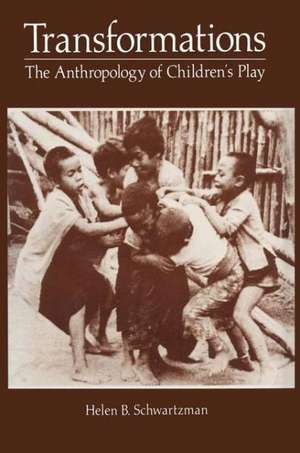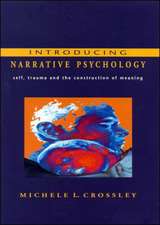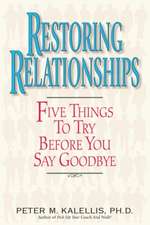Transformations: The Anthropology of Children’s Play
Editat de Helen Schwartzmanen Limba Engleză Paperback – 9 oct 2011
Preț: 896.04 lei
Preț vechi: 1092.72 lei
-18% Nou
Puncte Express: 1344
Preț estimativ în valută:
171.45€ • 179.03$ • 141.58£
171.45€ • 179.03$ • 141.58£
Carte tipărită la comandă
Livrare economică 15-29 aprilie
Preluare comenzi: 021 569.72.76
Specificații
ISBN-13: 9781461339403
ISBN-10: 1461339405
Pagini: 404
Ilustrații: XVIII, 380 p.
Dimensiuni: 152 x 229 x 21 mm
Greutate: 0.59 kg
Ediția:1978
Editura: Springer Us
Colecția Springer
Locul publicării:New York, NY, United States
ISBN-10: 1461339405
Pagini: 404
Ilustrații: XVIII, 380 p.
Dimensiuni: 152 x 229 x 21 mm
Greutate: 0.59 kg
Ediția:1978
Editura: Springer Us
Colecția Springer
Locul publicării:New York, NY, United States
Public țintă
ResearchDescriere
Writing a book about play leads to wondering. In writing this book, I wondered first if it would be taken seriously and then if it might be too serious. Eventually, I realized that these concerns were cast in terms of the major dichotomy that I wished to question, that is, the very perva sive and very inaccurate division that Western cultures make between play and seriousness (or play and work, fantasy and reality, and so forth). The study of play provides researchers with a special arena for re-thinking this opposition, and in this book an attempt is made to do this by reviewing and evaluating studies of children's transformations (their play) in relation to the history of anthropologists' transformations (their theories). While studying play, I have wondered in the company of many individuals. I would first like to thank my husband, John Schwartzman, for acting as both my strongest supporter and, as an anthropological colleague, my severest critic. His sense of nonsense is always novel as well as instructive. I am also very grateful to Linda Barbera-Stein for her Sherlock Holmes style help in locating obscure references, checking and cross-checking information, and patience and persistence in the face of what at times appeared to be bibliographic chaos. I also owe special thanks to my teachers of anthropology-Paul J. Bohannan, Johannes Fabian, Edward T. Hall, and Roy Wagner-whose various orientations have directly and indirectly influenced the approach presented in this book.
Cuprins
One Anthropological Play.- Play, Culture, and Anthropology.- Play: Definitions, Classifications, and Reductions.- Playing Anthropologist.- Two The Invention of Childhood.- Conceiving Childhood: The First Invention.- Reinventions of Childhood.- The American Cultivation of Childhood: 1830—1945.- The Cult of Childhood: 1945—1970.- The Culture of Childhood and Anthropologists’ Metaphors for Children.- The Child as Primitive.- The Child as Copycat.- The Child as Personality Trainee.- The Child as Monkey.- The Child as Critic.- The Great Pretenders.- Three Describing Play: Ethnographic Reports.- Asia.- Oceania.- Central and South America.- North America.- Africa.- Near East.- Europe.- Summary.- Four Staging Play: Evolutionary and Developmental Studies.- Stages and Survivals.- Recapitulation: G. Stanley Hall.- On Morals and Marbles: Jean Piaget.- The Ontogeny of Play.- Staging Play: Comment and Critique.- Summary.- Five Preserving Play: Diffusionism and Particularism.- Game Diffusion and the Patolli—Pachisi Debate.- Particularism: The Facts of Play.- William Wells Newell: American Children’s Games and Songs.- Early Collections and Classifications.- Walter Roth: Australian Aborigine Games.- Elsdon Best: Maori Children’s Games.- Paul G. Brewster: Game Collections and Classifications.- Brian Sutton-Smith: New Zealand and American Children’s Games.- Dorothy Howard: Australian Children’s Games.- Iona and Peter Opie: English Children’s Games and Rhymes.- Favorite Collectors’ Items.- Summary.- Six Socializing Play: Functional Analysis.- A. R. Radcliffe-Brown and Bronislaw Malinowski.- Functionalists and Play.- Socializing Play: The Kibbutz.- Socializing Play: The Australian Aborigine.- Socializing Play: The Kpelle.- Play and Sex Roles.- Games and Power Roles.- Imitation, Imagination, and Culture.- Play: Socialization, Satirization, or Innovation?.- Summary.- Seven Projecting Play: Culture and Personality.- Configurationists.- Psychocultural Analysis.- Freud on Play.- Projecting Play: The Pilagá.- Projecting Play: The Duau.- New Methodologies: The Hopi and the Balinese.- African Children’s Play: The Luba, Sanga, and Yeke.- Freudians on Play.- Statistics and Culture: Freud and Learning Theory.- Projecting Play in Six Cultures.- Games and Culture.- Summary.- Eight Saying Play: Communication Studies.- The Difference That Makes a Difference: Gregory Bateson.- Play and Paradox: The Message "This Is Play".- The Single Signal.- Winking or Blinking? Text and Context.- Saying Play: The Mescalero Apache Child.- Saying Play: The American Preschool Child.- Children’s Play in a Research Laboratory: Organizing Transformations.- Children’s Play in a Day-Care Center: Sideways Transformations.- Summary.- Nine Minding Play: Structural and Cognitive Studies.- The Player’s Perspective.- The Researcher’s Perspective.- Minding Play: Piaget versus Sutton-Smith.- Piaget’s Assimilation of Play.- Play and Learning.- Rhymes and Reasons: Children’s Verbal Play.- Play Languages.- Verbal Dueling.- Riddles.- Vocabulary Games.- Narratives.- Summary.- Ten Defining Play: Ecology, Ethology, and Experiments.- Environmental Definitions: Toys and Niches.- Behavioral Definitions: Child Ethology.- Play and Exploration.- Behavioral Definitions: Experimental Studies.- Play and Creativity.- Summary.- Eleven Conclusion: New Metaphors for Old.- Twelve Selected References and Films.- Films on Children’s Play.- Other Films of Interest to Play Researchers.- References.










